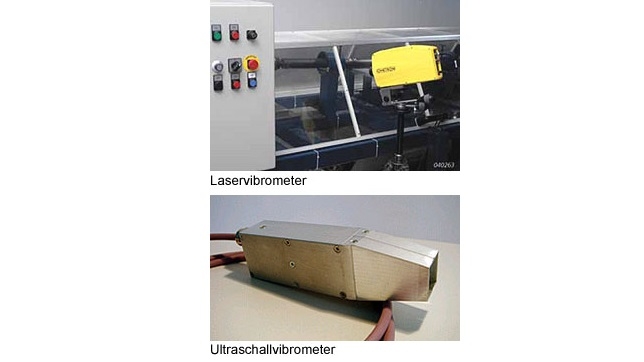Non-contact Vibration Sensors

- Enable the detection of structure-borne sound without contacting sensors and without clamping the test specimen
- In contrast to microphones, the non-contact vibration detection of vibrometers is not affected by ambient airborne sound, which makes them suitable for use in harsh production environments
- Areas of application are vibration analyses for assembly control, for end-of-line testing and in the area of laboratory and development
- Laser vibrometers are very often used in practice
Ultrasonic vibrometers offer comparable performance and allow better detection on rough, unmachined and untreated surfaces
Non-contact vibration sensors, also known as vibrometers, are used as vibration transducers for the contact-free detection of structure-borne sound for vibration analysis or acoustic testing. Microphones, on the other hand, are used to record airborne sound and are not included.
The measuring principle is based on scanning the surface of the object to be measured at a high frequency by laser beams or ultrasonic waves that are reflected from the surface. Due to the Doppler effect, the vibrations of the structure-borne sound cause a measurable frequency shift between the emitted laser beams or sound waves and the reflected ones received in the measuring head, whereby the vibration of the surface can be detected. In contrast to microphones, the vibration detection is not influenced by the airborne sound of the environment.
The non-contact vibration sensors detect the structure-borne sound via the reflection of laser light or ultrasonic waves. For this purpose, laser beams or ultrasonic waves are emitted from a measuring head at a high frequency, the reflection of which on the target surface is detected by sensors integrated in the measuring head. The vibration of the target surface by the structure-borne sound causes a frequency shift between the emitted and received light or ultrasonic waves due to the Doppler effect.
The most commonly used method is based on detection with laser beams. Optical laser vibrometers work particularly well on very smooth or painted surfaces. However, when measuring on rough or unmachined surfaces, so-called "speckles" can occur, where the emitted and received signals partially cancel each other out due to the roughness of the surface. Therefore, it may be necessary to attach mirrors to the target surface.
The acoustic ultrasonic vibrometer, on the other hand, is based on measurement with ultrasonic waves of a significantly longer wavelength and thus enables reliable measurement even on rough unmachined surfaces.
Suppliers: Non-contact Vibration Sensors
| Brüel & Kjaer Sound & Vibration Measurement A/S, Naerum, Denmark |
| Polytec GmbH, Waldbronn, Germany |
| Reilhofer KG, Karlsfeld, Germany |


